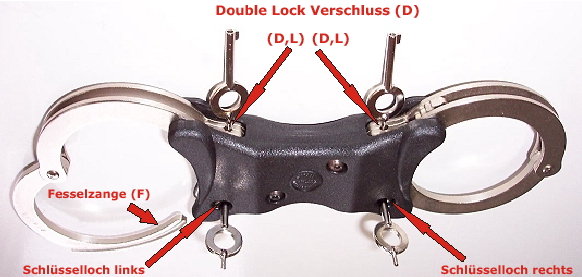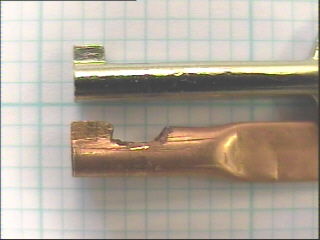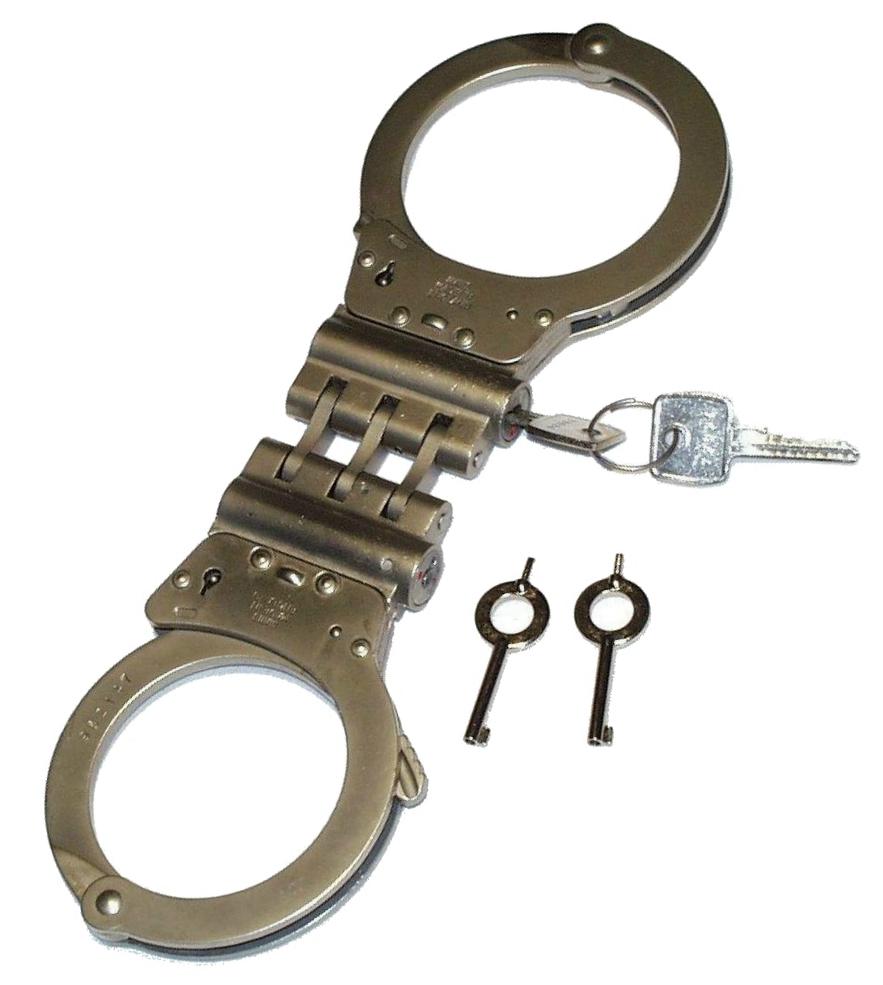
A Hiatts speedcuff - in common use by the police in Scotland
| 13 Apr '04 |
SCOTTISH NATIONAL STANDARD BEARER:
Peter Dow
 A Hiatts speedcuff - in common use by the police in Scotland |
 A helpful (German, I think) diagram that shows keys in the locks. Note the double-locking feature that uses the little poker (or pushpin) on the ring handle at the butt of the key to lock and to stop the handcuffs from tightening any further. Police torturers don't use that feature as they should - they want to cause as much pain and suffering as they can, so for them, the tighter the better. |
| Left lock Unlocking the "double-lock" Insert the key and turn it 190 degrees or so anti-clockwise. If you feel it unlocking after about 140 degrees then the lock was double-locked; if you feel no resistance then the lock wasn't double-locked but at least you know that now. Note: although it's now not "double-locked" you've still to unlock the "single-lock". Unlocking the "single-lock" With the key in the position that it is inserted at, try to turn the key 80 degrees or so clockwise. If you feel it unlocking on a spring action after about 40 degrees then keep the key turned against the spring and the cuff should now open, all being well; if the key stops after 40 degrees then it is because it is "double-locked" so unlock the double-lock first and try again. Note: always try unlocking the double-lock before trying to unlock the single-lock. |
Right lock Unlocking the "double-lock" Insert the key and turn it 190 degrees or so clockwise. If you feel it unlocking after about 140 degrees then the lock was double-locked; if you feel no resistance then the lock wasn't double-locked but at least you know that now. Note: although it's now not "double-locked" you've still to unlock the "single-lock". Unlocking the "single-lock" With the key in the position that it is inserted at, try to turn the key 80 degrees or so anti-clockwise. If you feel it unlocking on a spring action after about 40 degrees then keep the key turned against the spring and the cuff should now open, all being well; if the key stops after 40 degrees then it is because it is "double-locked" so unlock the double-lock first and try again. Note: always try unlocking the double-lock before trying to unlock the single-lock. |
|
Check your key |
There could be a problem with the manufacture of your key. In particular if the unlocking cam has not been made quite long enough then sometimes when trying to unlock the single-lock, the cam will only engage 2 out of the 3 independently floating locking bars - leaving the cuff still locked!
Try moving the key in or out slightly and re-try unlocking it. If that is a problem then it might be worthwhile to get a better made key.
The cam on a key supplied to me is only 3mm long and it doesn't work reliably, particularly when the cuff is under tension as it would be if the cuffs were applied tightly. So I'm alerting customers that keys supplied should not be trusted fully unless you've either tested the key yourself or measured it to see that it is the right size.
 The 3 independently floating locking bars pivot in a gap being measured here by inserting a 4.5mm drill bit. |
 A supplied key with a shorter cam sometimes won't open the cuff. A DIY copper key with a longer cam opens the lock more reliably. (Background: 2mm graph paper) |
Be prepared - get your own key
The picture below shows the kind of key that might be supplied with the standard Hiatts rigid handcuffs. You can't see it below but the right end of the key is hollow - tubular. In the picture at the top of this web page, you can just see the male pin in the lock in the handcuffs that fits the key's female hollow end.
Anyway, you've two choices to get your own keys, either order up all the keys you want from suppliers that you can find on the internet, (search for "Hiatts speedcuff UK") or, you could always order one key and then copy it to make additional keys.
 |
Handcuffs key from left to right: pushpin, ring handle, shaft, unlocking cam & tubular end; cm ruler. |
 | |
|
Copper tube can be used to make a light-weight (1.1 gram only!) handcuffs key. It can be bought from model-making shops for under £1 - enough for 9 keys if you've got the time and inclination. The outer diameter of the copper tube I used is specified by the supplier as 5/32 of an inch - nearly 4mm, although it was listed in the shop catalogue as 3.9mm.
I used a 2.5mm drill bit (or use a 3/32 of an inch drill bit) which I inserted into a piece of the copper tube and then I used pliers to form the tube around the drill bit to the correct shape. A section of tube was hack-sawed and ground out. Anyway, all the tools I used are shown in the photograph but please yourself, so long as you can arrange somehow to test your keys on handcuffs to ensure that they will actually work when you need them. I bought second-hand handcuffs to test my keys on from Springfields for about £18. Unfortunately, the key included by Springfields with the Hiatts handcuffs is not suitable, being the wrong size as explained earlier.
Attach your key to a length of elastic or string and loop it through the light glove you wear under your wrist protector cuff. (I sandpapered and then glued the handle of a DIY key to a 15cm or so length of elastic - see the photograph below). This would enable the key to be available to you in a hurry and saves you from having to fumble around in a pocket when the police are threatening.
 Future danger - high-security handcuffs
Future danger - high-security handcuffsThe design and production of a special purpose tool to force open handcuffs would then be a topical engineering challenge although meantime no doubt freedom fighters could manage to free protesters with an appropriate selection of locksmiths' tools: cordless (battery-powered) power tools, bolt-cutters and so on.
Click for engineering specification of the expected strength of handcuffs
 High security handcuffs |
A tip to delete the advertisement appearing on these pages.
CLICK TWICE in the top right hand corner of the ad.
First, click on the 'up' triangle and then click on the x.